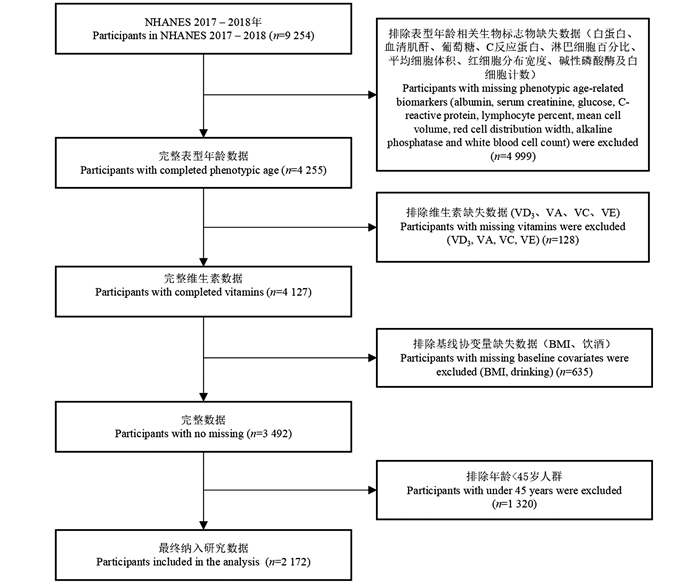Association between serum vitamins and biological aging in middle-aged and elderly people
-
摘要:
目的 探讨中老年人血清维生素与生物衰老速度之间的关联。 方法 基于2017―2018年美国国家健康与营养调查(National Health and Nutrition Examination Survey, NHANES)数据,纳入2 172名>45岁的研究对象。收集包括人口统计学资料、生活习惯和基础疾病史在内的协变量。利用多重线性回归分析模型,评估中老年人血清中的维生素C(vitamin C, VC)、维生素D3(vitamin D3, VD3)、维生素A(vitamin A, VA)和维生素E(vitamin E, VE)与生物衰老速度的关联性。采用分位数g-计算(quantile g-computation, QGCOMP)、加权分位数和(weighted quantile sum, WQS)2种回归方法,分析不同血清维生素对生物衰老速度的影响及其联合效应。 结果 研究对象平均年龄为(62.69±10.29)岁,男性与女性间血清维生素水平的差异均有统计学意义:VD3(Z=-2.376, P=0.017)、VC(Z=-7.230, P < 0.001)、VA(Z=6.418, P < 0.001)、VE(Z=-7.324, P < 0.001)。多重线性回归分析表明,VC与生物衰老速度呈负相关(β=-0.032, 95% CI: -0.041~-0.023, P < 0.001)。WQS与QGCOMP分析显示,血清维生素联合作用减缓衰老速度(β=-0.459, 95% CI: -0.585~-0.333, P < 0.001; β=-0.381, 95% CI: -0.538~-0.223, P < 0.001),VC在延缓衰老中起主要作用(权重:0.936, 0.885)。 结论 血清维生素是生物衰老的保护性因素,VC在减缓衰老速度的联合效应中作用最显著。 Abstract:Objective To investigate the association between serum levels of vitamins and the rate of biological aging in middle-aged and older adults. Methods Based on the 2017-2018 National Health and Nutrition Examination Survey (NHANES) data, a total of 2 172 study participants aged 45 years and above were enrolled. Demographic information, lifestyle habits and underlying disease history were collected. Multiple linear regression was used to assess the association between serum vitamins C (VC), vitamins D3 (VD3), vitamins A (VA) and vitamins E (VE) and the rate of biological aging in middle-aged and older adults. Quantile g-computation (QGCOMP) and weighted quantile sum (WQS) regression methods were applied to analyse the effects of different serum vitamins on the rate of biological ageing and their joint effects. Results The average age of the study population was (62.69 ± 10.29) years, and serum vitamin levels between male and female showed significant differences: VD3 (Z=-2.376, P=0.017), VC (Z=-7.230, P < 0.001), VA (Z=6.418, P < 0.001), and VE (Z=-7.324, P < 0.001). Multiple linear regression analyses showed that VC was negatively associated with the rate of biological aging (β=-0.032, 95% CI: -0.041-0.023, P < 0.001). WQS and QGCOMP analyses showed a joint effect of serum vitamins slowing down the rate of ageing (β=-0.459, 95% CI: -0.585-0.333, P < 0.001; β=-0.381, 95% CI: -0.538-0.223, P < 0.001), with VC playing the major role (weights: 0.936, 0.885). Conclusions Serum vitamins are protective factors in biological aging. VC plays the most significant role in the combined effect of slowing the rate of aging. -
Key words:
- Vitamins /
- Biological ageing /
- Combined effects
-
表 1 不同特征人群衰老速度比较结果
Table 1. Comparative results of the speed of ageing in people with different characteristics
变量Variable 人数
Number of people构成比
Proportion/%生物衰老速度①
Rate of biological ageingH/Z值
valueP值
value性别Gender 6.961 < 0.001 男Male 1 149 52.90 -3.41 (-6.70, 1.07) 女Female 1 023 47.10 -4.92 (-9.10, -0.56) 文化程度Education level 10.700 0.005 基础教育Elementary education 408 18.78 -3.89 (-7.57, 0.64) 中等教育Secondary education 547 25.18 -3.51 (-6.78, 0.74) 高等教育Higher education 1 217 56.03 -4.47 (-8.04, 0.04) 种族Race 136.000 < 0.001 墨西哥裔美国人Mexican American 245 11.28 -5.46 (-9.29, -1.76) 其他西班牙裔Other Hispanics 198 9.12 -5.41 (-7.78, -1.65) 非西班牙裔白人Non-Hispanic whites 912 41.99 -3.41 (-6.82, 0.50) 非西班牙裔黑人Non-Hispanic blacks 503 23.16 -2.06 (-6.25, 2.70) 其他种族Other races 314 14.46 -7.16 (-10.44, -2.31) 婚姻状况Marital status 24.200 < 0.001 有伴侣Have a mate 1 302 59.94 -4.48 (-8.04, -0.15) 曾经有伴侣Had a mate 713 32.83 -3.53 (-7.10, 0.90) 从未有伴侣Never had a mate 157 7.23 -2.07 (-6.34, 3.41) 贫困指数Poverty index 72.300 < 0.001 < 1.3 527 24.26 -2.48 (-6.50, 2.19) 1.3~3.5 930 42.82 -3.61 (-7.46, 0.89) >3.5 715 32.92 -5.46 (-8.58, -1.92) BMI/(kg·m-2) 177.000 < 0.001 < 25 475 21.87 -6.37 (-10.53, -1.79) 25~30 745 34.30 -5.16 (-8.16, -1.41) >30 952 43.83 -2.03 (-5.73, 2.25) 可替宁Cotinine/(ng·mL-1) 119.000 < 0.001 < 0.011 843 38.81 -5.37 (-8.67, -1.46) 0.011~<0.033 360 16.57 -4.61 (-8.20, -0.87) 0.033~16.300 500 23.02 -3.72 (-7.22, 1.16) >16.300 469 21.59 -1.42 (-5.35, 2.88) 饮酒Drinking 30.900 < 0.001 从不饮酒Never drinking 660 30.39 -3.14 (-6.84, 2.16) 轻度饮酒Light drinking 572 26.34 -4.68 (-8.67, -0.30) 重度饮酒Heavy drinking 940 43.28 -4.35 (-7.73, -0.57) 高血压Hypertension -5.596 < 0.001 否No 1 033 47.56 -5.14 (-8.83, -1.44) 是Yes 1 139 52.44 -2.70 (-6.73, 1.88) 糖尿病Diabetes mellitus -7.130 < 0.001 否No 1 536 70.72 -4.68 (-8.01, -0.67) 是Yes 636 29.28 -2.19 (-6.58, 2.57) 心血管病Cardiovascular disease -9.246 < 0.001 否No 1 750 80.57 -4.64 (-8.13, -0.50) 是Yes 422 19.43 -1.29 (-5.57, 3.85) 注:①对于非正态分布的连续变量,表示为M(P25, P75)。
Note: ① For non-normally distributed continuous variables, denoted M(P25, P75).表 2 血清维生素与生物衰老速度的联合效应估计结果
Table 2. Results of the estimation of the combined effect of serum vitamins and biological ageing
方法
Methods总人群Total 男性Male 女性Female β值value
(95% CI)t值
valueP值
valueβ值value
(95% CI)t值
valueP值
valueβ值value
(95% CI)t值
valueP值
valueQGCOMP 模型1 Model 1 -0.526(-0.684~-0.368) -6.525 < 0.001 -0.390(-0.626~-0.154) -3.243 0.001 -0.634(-0.851~-0.417) -5.723 < 0.001 模型2 Model 2 -0.331(-0.491~-0.171) -4.048 < 0.001 -0.179(-0.421~0.064) -1.446 0.150 -0.450(-0.666~-0.233) -4.071 < 0.001 模型3 Model 3 -0.381(-0.538~-0.223) -4.731 < 0.001 -0.226(-0.463~0.011) -1.866 0.060 -0.495(-0.712~-0.277) -4.459 < 0.001 WQS 模型1 Model 1 -0.592(-0.720~-0.463) -9.013 < 0.001 -0.527(-0.701~-0.353) -5.944 < 0.001 -0.615(-0.819~-0.412) -5.924 < 0.001 模型2 Model 2 -0.458(-0.586~-0.330) -7.007 < 0.001 -0.396(-0.564~-0.227) -4.605 < 0.001 -0.429(-0.635~-0.223) -0.196 < 0.001 模型3 Model 3 -0.459(-0.585~-0.333) -7.118 < 0.001 -0.408(-0.574~-0.243) -4.845 < 0.001 -0.447(-0.660~-0.233) -4.101 < 0.001 注:QGCOMP,分位数g-计算; WQS,加权分位数和。
Note: QGCOMP, quantile g-computation; WQS, weighted quantile sum.表 3 血清维生素与生物衰老速度的联合效应的敏感性分析
Table 3. Results of sensitivity analysis of the combined effect of serum vitamins and biological ageing
方法
Methods总人群Total 男性Male 女性Female β值value
(95% CI)t值
valueP值
valueβ值value
(95% CI)t值
valueP值
valueβ值value
(95% CI)t值
valueP值
valueQGCOMP 模型1 Model 1 -0.550(-0.703~-0.397) -7.157 < 0.001 -0.363(-0.581~-0.146) -3.196 0.042 -0.670(-0.875~-0.466) -6.951 < 0.001 模型2 Model 2 -0.350(-0.505~-0.196) -4.501 < 0.001 -0.168(-0.398~0.006) -1.434 0.152 -0.466(-0.673~-0.230) -4.600 < 0.001 模型3 Model 3 -0.402(-0.551~-0.254) -5.296 < 0.001 -0.218(-0.438~0.001) -1.943 0.052 -0.516(-0.721~-0.312) -5.180 < 0.001 WQS 模型1 Model 1 -0.601(-0.745~-0.458) -8.222 < 0.001 -0.579(-0.761~-0.397) -6.234 < 0.001 -0.778(-0.998~-0.559) -6.949 < 0.001 模型2 Model 2 -0.443(-0.581~-0.306) -6.313 < 0.001 -0.444(-0.624~-0.264) -4.840 < 0.001 -0.535(-0.752~-0.318) -4.827 < 0.001 模型3 Model 3 -0.424(-0.569~-0.279) -5.741 < 0.001 -0.433(-0.613~-0.254) -4.727 < 0.001 -0.527(-0.744~-0.311) -4.783 < 0.001 注:QGCOMP,分位数g-计算; WQS,加权分位数和。
Note: QGCOMP, quantile g-computation; WQS, weighted quantile sum. -
[1] Rivero-Segura NA, Bello-Chavolla OY, Barrera-Vázquez OS, et al. Promising biomarkers of human aging: in search of a multi-omics panel to understand the aging process from a multidimensional perspective[J]. Ageing Res Rev, 2020, 64: 101164. DOI: 10.1016/j.arr.2020.101164. [2] Ng TP, Zhong X, Gao Q, et al. Socio-environmental, lifestyle, behavioural, and psychological determinants of biological ageing: the Singapore longitudinal ageing study[J]. Gerontology, 2020, 66(6): 603-613. DOI: 10.1159/000511211. [3] Kresovich JK, Park YM, Keller JA, et al. Healthy eating patterns and epigenetic measures of biological age[J]. Am J Clin Nutr, 2022, 115(1): 171-179. DOI: 10.1093/ajcn/nqab307. [4] 赵翰卿, 李欣怡, 汪瑞琦, 等. 维生素家族对免疫细胞影响的研究进展[J]. 生命科学, 2020, 32(4): 343-348. DOI: 10.13376/j.cbls/2020044.Zhao HQ, Li XY, Wang RQ, et al. Research progress of the vitamin family on immunocytes[J]. Chinese Bulletin of Life Sciences, 2020, 32(4): 343-348. DOI: 10.13376/j.cbls/2020044. [5] 翟卫民. 维生素C研究进展及其在宠物临床中的应用[J]. 现代畜牧兽医, 2022, (3): 64-67.Zhai WM. Progress in vitamin C research and its application in pet clinic[J]. Mod J Anim Husb Vet Med, 2022, (3): 64-67. [6] Chen YC, Sung HC, Chuang TY, et al. Vitamin D (3) decreases TNF-α-induced inflammation in lung epithelial cells through a reduction in mitochondrial fission and mitophagy[J]. Cell Biol Toxicol, 2022, 38(3): 427-450. DOI: 10.1007/s10565-021-09629-6. [7] Sirakawin C, Lin DF, Zhou ZY, et al. SKN-1/NRF2 upregulation by vitamin A is conserved from nematodes to mammals and is critical for lifespan extension in elegans[J]. Aging cell, 2024, 23(3): e14064. DOI: 10.1111/acel.14064. [8] Liu C, Hua L, Xin Z. Synergistic impact of 25-hydroxyvitamin D concentrations and physical activity on delaying aging[J]. Redox Biol, 2024, 73: 103188. DOI: 10.1016/j.redox.2024.103188. [9] Chen TC, Clark J, Riddles MK, et al. National health and nutrition examination survey, 2015-2018: sample design and estimation procedures[J]. Vital Health Stat 2, 2020, (184): 1-35. [10] Levine ME, Lu AT, Quach A, et al. An epigenetic biomarker of aging for lifespan and healthspan[J]. Aging, 2018, 10(4): 573-591. DOI: 10.18632/aging.101414. [11] Keil AP, Buckley JP, O'Brien KM, et al. A quantile-based g-computation approach to addressing the effects of exposure mixtures[J]. Environ Health Perspect, 2020, 128(4): 47004. DOI: 10.1289/EHP5838. [12] Carrico C, Gennings C, Wheeler DC, et al. Characterization of weighted quantile sum regression for highly correlated data in a risk analysis setting[J]. J Agric Biol Environ Stat, 2015, 20(1): 100-120. DOI: 10.1007/s13253-014-0180-3. [13] López-Otín C, Blasco MA, Partridge L, et al. Hallmarks of aging: an expanding universe[J]. Cell, 2023, 186(2): 243-278. DOI: 10.1016/j.cell.2022.11.001. [14] 王佳琪, 胡加亮, 徐寒梅. 衰老机制及抗衰老药物的研究进展[J]. 药学进展, 2023, 47(2): 154-160. DOI: 10.20053/j.issn1001-5094.2023.02.010.Wang JQ, Hu JL, Xu HM. Mechanism of aging and anti-aging drug development[J]. Prog Pharm Sci, 2023, 47(2): 154-160. DOI: 10.20053/j.issn1001-5094.2023.02.010. [15] West BJ, Deng SX, Palu 'K. Vitamin C, grape seed extract and Citrus bioflavonoids protect the skin against photoaging: a review[J]. J Biosci Med, 2020, 8(12): 116-134. DOI: 10.4236/jbm.2020.812012. [16] Hassan E, Al-Zuhairi W, Ibrahim W. Antioxidants and their role in preventing diseases: a review[J]. Earthline J Math Sci, 2022: 165-182. DOI: 10.34198/ejcs.7222.165182. [17] Sanz R, Mazzei L, Santino N, et al. Vitamin D-mitochondria cross-talk could modulate the signaling pathway involved in hypertension development: a translational integrative overview[J]. Clin Investig Arterioscler, 2020, 32(4): 144-155. DOI: 10.1016/j.arteri.2020.02.002. [18] Ciarcià G, Bianchi S, Tomasello B, et al. Vitamin E and non-communicable diseases: a review[J]. Biomedicines, 2022, 10(10): 2473. DOI: 10.3390/biomedicines10102473. [19] Fata GL, van Vliet N, Barnhoorn S, et al. Vitamin E supplementation reduces cellular loss in the brain of a premature aging mouse model[J]. J Prev Alzheimers Dis, 2017, 4(4): 226-235. DOI: 10.14283/jpad.2017.30. [20] Souza F, Machado K. Benefícios da utilização da vitamina A tópica e seus derivados na prevenção do envelhecimento cutâneo /benefits of the use of vitamin A topical and its derivatives in the prevention of skin aging[J]. Id on Line Rev Psic, 2022, 16: 702-717. DOI: 10.14295/idonline.v16i60.3456. [21] Cai Y, Zhong YD, Zhang H, et al. Association between dietary vitamin C and telomere length: a cross-sectional study[J]. Front Nutr, 2023, 10: 1025936. DOI: 10.3389/fnut.2023.1025936. [22] Yu LL, Liu W, Wang X, et al. A review of practical statistical methods used in epidemiological studies to estimate the health effects of multi-pollutant mixture[J]. Environ Pollut, 2022, 306: 119356. DOI: 10.1016/j.envpol.2022.119356. [23] 白璐, 谢卓霖, 王智文, 等. 维生素C对炎症的治疗作用[J]. 临床与病理杂志, 2021, 41(12): 2973-2979. DOI: 10.3978/j.issn.2095-6959.2021.12.036.Bai L, Xie ZL, Wang ZW, et al. Therapeutic effect of vitamin C on inflammation[J]. J Clin Pathol Res, 2021, 41(12): 2973-2979. DOI: 10.3978/j.issn.2095-6959.2021.12.036. [24] Mahammoud M, Elshawi O, Moawad F, et al. Neuromodulatory influences of vitamin C on D-galactose induced neuronal metabolic dysfunction model[J]. Benha Vet Med J, 2021, 40: 80-83. DOI: 10.21608/bvmj.2021.67215.1360. -





 下载:
下载:



